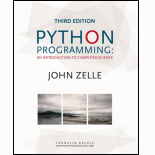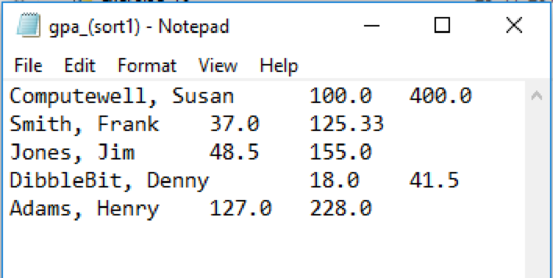
Modified gpasort program
Program plan:
- Import the necessary modules in “grade_sort.py” file.
- Define the “make_Student()” function,
- Returns student record values to the caller.
- Define the “read_Students()” function,
- Returns the list of student record to the caller.
- Define the “write_Students()” function,
- Write the student record.
- Define the “sort()” function,
- Create empty list.
- Create “for” loop,
- Assign the data from the file.
- Append the data to the new list using append() method.
- Call the function “sort()” to sort the data.
- Call the function “reverse()” to reverse the data.
- Return new list.
- Define the “main()” function,
- Assign the input file.
- Read the students record from the input file.
- Sort the data by calling “sort()” function.
- Assign the output file.
- Call the function “write_Students()”.
- Call the “main()” function.
- Create a class Student in “gpa.py” file,
- Define the “_init_()” method.
- Assign name hours and GPoints.
- Define the “get_Name()” method.
- Return the name.
- Define the “get_Hours()” method.
- Return hours.
- Define the “getQ_Points()” method.
- Return GPoints.
- Define the “gpa()” method.
- Return gpa
- Define the “make_Student()” method.
- Return name, hours, and grade points.
- Define the “main()” function.
- Define the “get_Name()” method.
- Assign name hours and GPoints.
- Define the “_init_()” method.
- Call the “main()” function.
Explanation of Solution
Program:
File name: “gpa_sort.py”
#Import required module
from gpa import Student
#Define the function make_Student()
def make_Student(info_Str):
#Make multiple assignment
Name, Hours, Gpoints = info_Str.split("\t")
#Return constructor
return Student(Name, Hours, Gpoints)
#Define the function read_Students()
def read_Students(file_name):
#Open the input file for reading
in_file = open(file_name, 'r')
#Create an empty list
Students = []
#Create for loop to iterate over all lines in a file
for line in in_file:
#Append the line in a list
Students.append(make_Student(line))
#Close the input file
in_file.close()
#Return the list
return Students
#Define the function write_Students()
def write_Students(Students, file_name):
#Open output file to write
out_file = open(file_name, 'w')
#Create a for loop to iterate over list
for s in Students:
#Print output
print("{0}\t{1}\t{2}".format(s[1],
s[2], s[3]), file = out_file)
#Close the output file
out_file.close()
#Define the function
def sort(Students):
#Create empty list
new_Data = []
#Create for loop
for i in range(len(Students)):
#Assign tuple
x = (Students[i].gpa(), Students[i].get_Name(),
Students[i].get_Hours(), Students[i].getQ_Points())
#Append the data at the end of new list
new_Data.append(x)
#Call the function "sort()" to sort the data
new_Data.sort()
#Call the function "reverse()" to reverse the data
new_Data.reverse()
#Return new list
return new_Data
#Define main() function
def main():
#Print the string
print("This program sorts student grade information by GPA")
#Assign the file name
file_name = "gpa1.txt"
#Read the data from a file
data = read_Students(file_name)
#Sort the data
data = sort(data)
#Assign the file name
file_name = "gpa_(sort1).txt"
#Call the function
write_Students(data, file_name)
if __name__ == '__main__':
#Call the main() function
main()
File name: “gpa.py”
#Create a class Student
class Student:
#Define _init_() method
def __init__(self, Name, Hours, Gpoints):
self.Name = Name
self.Hours = float(Hours)
self.Gpoints = float(Gpoints)
#Define get_Name() method
def get_Name(self):
#Return the name
return self.Name
#Define get_Hours()
def get_Hours(self):
#return hours
return self.Hours
#Define getQ_Points()
def getQ_Points(self):
#return grade points
return self.Gpoints
#Define the function gpa()
def gpa(self):
#return the value
return self.Gpoints / self.Hours
#Define the function make_Student()
def make_Student(info_Str):
#Make multiple assignment
Name, Hours, Gpoints = info_Str.split("\t")
#Return the constructor
return Student(Name, Hours, Gpoints)
#Define the main() function
def main():
#Open the input file for reading
file_name = input("Enter the name of the grade file: ")
in_file = open(file_name, 'r')
#Set best to the record for the first student in the file
best = make_Student(in_file.readline())
#Process lines of the file using "for" loop
for line in in_file:
#Make the line of file into a student record
s = make_Student(line)
#Checck whether the student is best so far
if s.gpa() > best.gpa():
#Assign the best student record
best = s
#Close the input file
in_file.close()
#Print information about the best student
print("The best student is:", best.get_Name())
print("Hours:", best.get_Hours())
print("GPA:", best.gpa())
if __name__ == '__main__':
#Call the main() function
main()
Contents of “gpa1.txt”
Adams, Henry 127 228
Computewell, Susan 100 400
DibbleBit, Denny 18 41.5
Jones, Jim 48.5 155
Smith, Frank 37 125.33
Output:
This program sorts student grade information by GPA
>>>
Screenshot of output file “gps_(sort1).txt after execution:

Want to see more full solutions like this?
Chapter 11 Solutions
Python Programming: An Introduction to Computer Science
- 2:21 m Ο 21% AlmaNet WE ARE HIRING Experienced Freshers Salesforce Platform Developer APPLY NOW SEND YOUR CV: Email: hr.almanet@gmail.com Contact: +91 6264643660 Visit: www.almanet.in Locations: India, USA, UK, Vietnam (Remote & Hybrid Options Available)arrow_forwardProvide a detailed explanation of the architecture on the diagramarrow_forwardhello please explain the architecture in the diagram below. thanks youarrow_forward
- Complete the JavaScript function addPixels () to calculate the sum of pixelAmount and the given element's cssProperty value, and return the new "px" value. Ex: If helloElem's width is 150px, then calling addPixels (hello Elem, "width", 50) should return 150px + 50px = "200px". SHOW EXPECTED HTML JavaScript 1 function addPixels (element, cssProperty, pixelAmount) { 2 3 /* Your solution goes here *1 4 } 5 6 const helloElem = document.querySelector("# helloMessage"); 7 const newVal = addPixels (helloElem, "width", 50); 8 helloElem.style.setProperty("width", newVal); [arrow_forwardSolve in MATLABarrow_forwardHello please look at the attached picture. I need an detailed explanation of the architecturearrow_forward
- Information Security Risk and Vulnerability Assessment 1- Which TCP/IP protocol is used to convert the IP address to the Mac address? Explain 2-What popular switch feature allows you to create communication boundaries between systems connected to the switch3- what types of vulnerability directly related to the programmer of the software?4- Who ensures the entity implements appropriate security controls to protect an asset? Please do not use AI and add refrencearrow_forwardFind the voltage V0 across the 4K resistor using the mesh method or nodal analysis. Note: I have already simulated it and the value it should give is -1.714Varrow_forwardResolver por superposicionarrow_forward
- Describe three (3) Multiplexing techniques common for fiber optic linksarrow_forwardCould you help me to know features of the following concepts: - commercial CA - memory integrity - WMI filterarrow_forwardBriefly describe the issues involved in using ATM technology in Local Area Networksarrow_forward
 C++ Programming: From Problem Analysis to Program...Computer ScienceISBN:9781337102087Author:D. S. MalikPublisher:Cengage Learning
C++ Programming: From Problem Analysis to Program...Computer ScienceISBN:9781337102087Author:D. S. MalikPublisher:Cengage Learning EBK JAVA PROGRAMMINGComputer ScienceISBN:9781337671385Author:FARRELLPublisher:CENGAGE LEARNING - CONSIGNMENT
EBK JAVA PROGRAMMINGComputer ScienceISBN:9781337671385Author:FARRELLPublisher:CENGAGE LEARNING - CONSIGNMENT Microsoft Visual C#Computer ScienceISBN:9781337102100Author:Joyce, Farrell.Publisher:Cengage Learning,
Microsoft Visual C#Computer ScienceISBN:9781337102100Author:Joyce, Farrell.Publisher:Cengage Learning, New Perspectives on HTML5, CSS3, and JavaScriptComputer ScienceISBN:9781305503922Author:Patrick M. CareyPublisher:Cengage LearningProgramming Logic & Design ComprehensiveComputer ScienceISBN:9781337669405Author:FARRELLPublisher:Cengage
New Perspectives on HTML5, CSS3, and JavaScriptComputer ScienceISBN:9781305503922Author:Patrick M. CareyPublisher:Cengage LearningProgramming Logic & Design ComprehensiveComputer ScienceISBN:9781337669405Author:FARRELLPublisher:Cengage C++ for Engineers and ScientistsComputer ScienceISBN:9781133187844Author:Bronson, Gary J.Publisher:Course Technology Ptr
C++ for Engineers and ScientistsComputer ScienceISBN:9781133187844Author:Bronson, Gary J.Publisher:Course Technology Ptr





